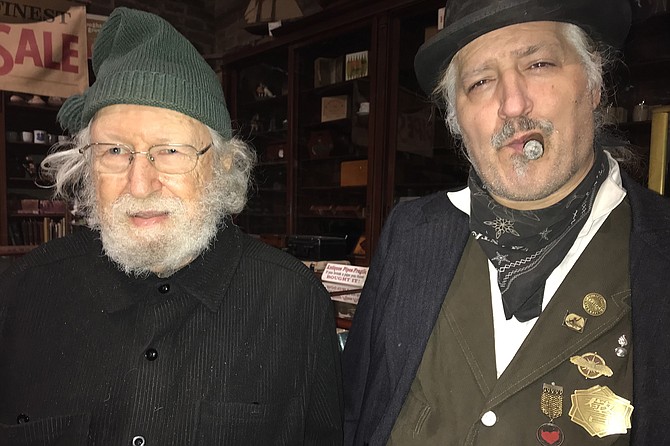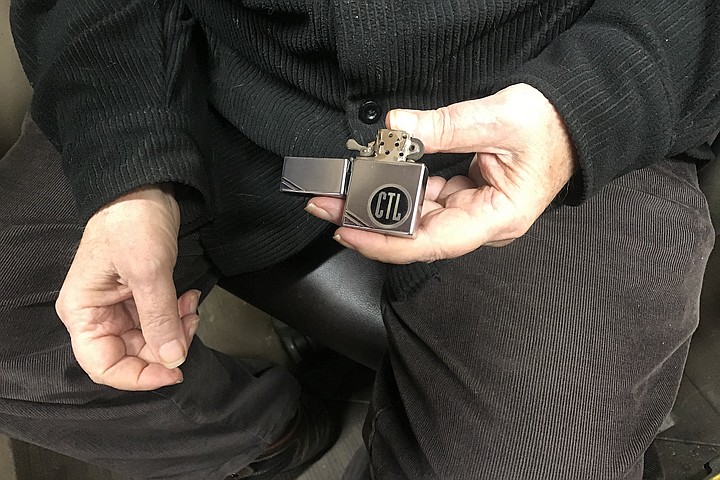 Facebook
Facebook
 X
X
 Instagram
Instagram
 TikTok
TikTok
 Youtube
Youtube

In a Dickensian back room behind the tobacconists Racine & Laramie, in Old Town Plaza, Geoffrey Mogilner rifles through the contents of his high security safe. “It’s somewhere here. I would never put it on display. Ah!”
He hauls out a folded envelope, secured by two paper clips. He slides the clips off, and brings out a little plastic bag. He tips it up. Something heavy drops into his hand.
“The last one that sold fetched $32,000,” he says.
He’s holding an old Zippo lighter, the kind that was known as much for the ping it made when you flicked it open as for its claim to be windproof.
“These were the very first Zippo lighters, 1932, 33,” he says. “I was so lucky. I bought it from the lady who actually made it in Zippo’s factory in Bradford, Pennsylvania. See the hinge? Outside hinge.”

Since 1932, Zippo has sold a bunch. In 2012, they made their 500 millionth lighter. Many are emblazoned with military insignia, like the one I just saw with “Franklin D. Roosevelt, CVA 42” embossed on it. Or another with “USS Langley,” the very first US aircraft carrier.
“Zippo was a cultural icon right up to the deglamorization of tobacco products in the 1980s,” says Geoffrey’s colleague (dressed in Civil War garb) Jeff Lawing, who’s helping me ID some of the aircraft carrier Zippos on display, “Ninety percent of the military folks smoked, especially Navy and Marine Corps. So it was pretty much a staple thing for every single commanding officer to order a large amount of Zippos with the unit embossed on it. It was like the challenge coin, a custom which came from the US Army and the Air Force. It was handed out to dignitaries. Because they could be extremely useful. The custom is, when you’re in a bar and you smack the coin down, that means that if your neighbor doesn’t have his, he has to buy the round. But smacking down a Zippo with your logo is just as good.”

Besides, Jeff says, “You always had to have a light anyway so you could light the lady’s cigarette. Just look at Hollywood movies of the ‘30s and ‘40s. That was the gentlemanly thing to do.”
But for Geoffrey Mogilner, this is his most special Zippo — and he has a huge collection. It is one of the very first Zippos ever made.
“The lady who made it discovered me through an article I wrote about Navy Zippos,” he says. He had published it in a glossy Japanese magazine, Zippo Manual 2, devoted entirely to Zippos. She read it in Pennsylvania and sent this letter to Geoff, and he ended up buying (for an undisclosed sum) the lighter which she personally made in 1932-3.
Out in the beautifully Old West Racine & Laramie store, he displays hundreds of Navy Zippos, each embossed with the name and numbers of a ship or submarine. But he won’t put this out there.
“Too valuable,” he says. “Somebody would steal it.”
Like, a collector?
He just smiles.


In a Dickensian back room behind the tobacconists Racine & Laramie, in Old Town Plaza, Geoffrey Mogilner rifles through the contents of his high security safe. “It’s somewhere here. I would never put it on display. Ah!”
He hauls out a folded envelope, secured by two paper clips. He slides the clips off, and brings out a little plastic bag. He tips it up. Something heavy drops into his hand.
“The last one that sold fetched $32,000,” he says.
He’s holding an old Zippo lighter, the kind that was known as much for the ping it made when you flicked it open as for its claim to be windproof.
“These were the very first Zippo lighters, 1932, 33,” he says. “I was so lucky. I bought it from the lady who actually made it in Zippo’s factory in Bradford, Pennsylvania. See the hinge? Outside hinge.”

Since 1932, Zippo has sold a bunch. In 2012, they made their 500 millionth lighter. Many are emblazoned with military insignia, like the one I just saw with “Franklin D. Roosevelt, CVA 42” embossed on it. Or another with “USS Langley,” the very first US aircraft carrier.
“Zippo was a cultural icon right up to the deglamorization of tobacco products in the 1980s,” says Geoffrey’s colleague (dressed in Civil War garb) Jeff Lawing, who’s helping me ID some of the aircraft carrier Zippos on display, “Ninety percent of the military folks smoked, especially Navy and Marine Corps. So it was pretty much a staple thing for every single commanding officer to order a large amount of Zippos with the unit embossed on it. It was like the challenge coin, a custom which came from the US Army and the Air Force. It was handed out to dignitaries. Because they could be extremely useful. The custom is, when you’re in a bar and you smack the coin down, that means that if your neighbor doesn’t have his, he has to buy the round. But smacking down a Zippo with your logo is just as good.”

Besides, Jeff says, “You always had to have a light anyway so you could light the lady’s cigarette. Just look at Hollywood movies of the ‘30s and ‘40s. That was the gentlemanly thing to do.”
But for Geoffrey Mogilner, this is his most special Zippo — and he has a huge collection. It is one of the very first Zippos ever made.
“The lady who made it discovered me through an article I wrote about Navy Zippos,” he says. He had published it in a glossy Japanese magazine, Zippo Manual 2, devoted entirely to Zippos. She read it in Pennsylvania and sent this letter to Geoff, and he ended up buying (for an undisclosed sum) the lighter which she personally made in 1932-3.
Out in the beautifully Old West Racine & Laramie store, he displays hundreds of Navy Zippos, each embossed with the name and numbers of a ship or submarine. But he won’t put this out there.
“Too valuable,” he says. “Somebody would steal it.”
Like, a collector?
He just smiles.
Comments